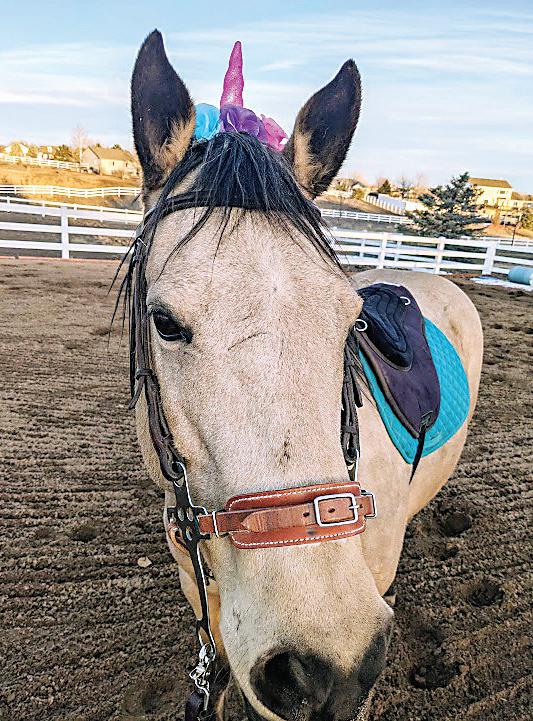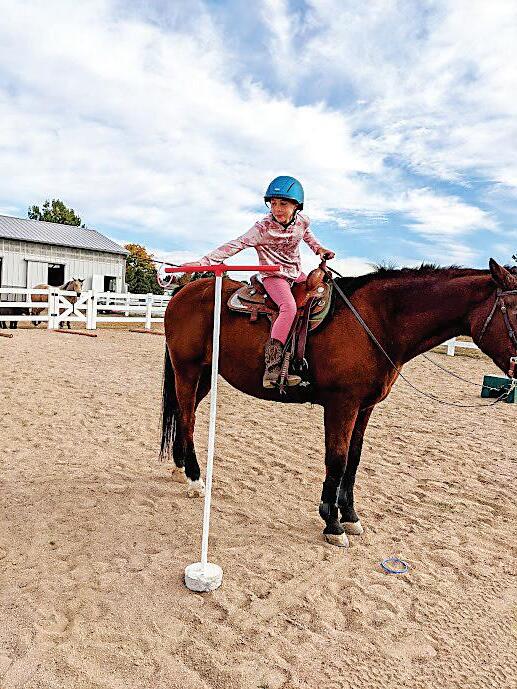
7 minute read
BUILDING 103
FROM PAGE 7 certi cations in early childhood education.
Getting started e study suggested that the county should consider options for expanding center-based child care in the region and evaluate the potential for nancial support.
A study performed in 2019 funded by the county, the Clear Creek Economic Development Corp. and a grant from the Henderson Mine found that child care was needed in the county, and parents are making do with nannies, neighbors, friends and family members, with some watching their children themselves because they can’t a ord child care, which means they don’t work.
“ at survey pointed out things we knew,” said Mitch Houston, executive director of the Clear Creek Schools Foundation, which is helping to facilitate the center for the school district, rec district and the county. “It said there were 8.5 kids for each early-learning seat in the county. at wakes one up.”
To begin facilitating the plan, the partners have received $1.6 million from three grants: an EPIC — Executives Partnering to Invest in Children — grant to begin designing a business model for the center; a state Department of Early Childhood grant to help with construction; and a CIRCLE — Community Innovation and Resilience for Care and Learning Equity — grant to help get the center operational.
Houston hopes to obtain about $2 million in additional grants to get the early-learning center running.
Houston has been looking at a variety of early-learning center models around the state, noting that he’s learning that many di erent business models are available, “which validates that there’s room to be exible and do what’s right for your community.”
The early learning center e rec district operates the only child-care facility in the county outside of the school programs, o ering before- and after-school camps during the school year, camps in the summer plus toddler-time activities during which parents must be in the rec center.
“We are perpetually working to serve as many families as we can,” said Cameron Marlin, the Clear
Creek Metropolitan Recreation District executive director. “When discussions were getting started, we were adamant about getting involved.”
Marlin and Caitlin Morris, the rec district’s director of child care, have been involved in the center since the beginning, and they want to incorporate the outdoors from an early childhood education perspective.
“We looked at the initial design process and how each classroom has access to the outdoors,” Marlin said. “We want to put natural objects in the décor. We want less plastic and more wood. How do we incorporate the outdoors even in the indoors?”
From the rec district perspective, getting young people interested in recreational activities hopefully will lead to a lifelong love or the outdoors and recreation, Marlin said.
“It’s really about engaging with community members from an early age,” Marlin said. “We can be part of their health and wellness journey.”
Training early-childhood educators
Part of the plan is providing training to people interested in working in early-childhood education, Houston said, especially since the 2019 study said the greatest barrier to o ering child care in the county was the lack of quali ed sta .
“ e pool of quali ed sta is relatively low due to the size of the community and high housing costs make it di cult to keep good employees in the community with wages typical of the child care industry,” the study stated. “Even when sta are available, they are not necessarily fully quali ed. Providers then spend resources to provide training to these sta without assurance that they will remain long-term employees.”
Houston said the early childhood center will give high school students and community members the opportunity to become quali ed to teach in the Idaho Springs center or elsewhere.
“We want to help with professional development, pay a living wage and o er full bene ts,” Houston said. “We are building professional positions.”
Marlin added: “In terms of employment, we are expanding our scope of employment opportunities by providing livable wages for these jobs. It’s an exciting time for childcare providers to be recognized for the value they contribute.”
Visit clearcreekkids.org to learn more about the early childhood education center in Idaho Springs.
Let’s talk steaks. Steaks that are tender, juicy, and full of flavor. Perfectly aged, hand-trimmed, one-of-a-kind steaks that are GUARANTEED to be perfect, every single time. These aren’t just steaks. These are Omaha Steaks.

Therapists describe how they incorporate horses into their practice
BY TAYLER SHAW TSHAW@COLORADOCOMMUNITYMEDIA.COM
When people think of horses, they might associate them with ranch living, horse racing or recreational riding, but horses can be therapeutic, too. erapy takes many forms, from physical to mental. Some people travel to a ranch to work with horses as part of the therapeutic process.
Equine-assisted therapy was something Arvada native Kelsey Petitt discovered while studying occupational therapy at Pima Medical Institute in Denver. Having grown up riding horses, it immediately caught her attention.


“I just, kind of, was like, ‘Oh my gosh, this is the coolest thing ever. I can combine my true passion of horses and really being able to help and assist participants and patients with doing therapy and reaching their functional goals while also having fun with horses and having that relationship,’” Petitt said.
Although she knew immediately that equine-assisted therapy was something she wanted to pursue, she did not do so immediately. Following her schooling and clinical internships, she quickly began working and then had her daughter.
However, in 2021 Petitt, who now lives in Brighton, decided to establish the Brighton-based Prestige erapeutic Equestrian Center, o ering an occupational therapy program that brings the four-legged companions into the practice.
“Now, I’m going on 11 years of being a therapist and so it’s taken me a little bit of time to get back to, really, what I wanted to do,” said Petitt, who also works as an occupational therapy assistant for a company called erapeutic and Rehabilitative Associates.
Her purpose, like many other therapists incorporating horses into their practice, is clear: “Transforming lives through the therapeutic power of horses.”
Bringing horses into occupational therapy
Occupational therapists help people develop skills so that they can perform day-to-day tasks such as bathing, dressing and eating, as well as techniques to aid in memory and concentration, according to the American Occupational erapy Association.
For example, occupational therapists may work on a person’s ne motor skills, such as being able to button a jacket or holding a fork, Petitt said.
ey also work on sensory integration, which she said usually comes up when working with someone who is on the autism spectrum.
Another example of work they do is helping someone with their feeding skills, such as for patients with Parkinson’s disease who experience a lot of tremors. Improving core strength may also be a focus for patients, such as for someone who struggles to put their shirt on due to a lack of strength.
“ ere’s an array of di erent settings that you can get into in the occupational therapy eld, but I think for me, the equine-assisted movement is just something that I’ve always loved,” she said. “Horses are just so therapeutic in general, for anybody.” e term “hippotherapy” refers to how occupational therapy, physical therapy and speech-language pathology professionals use equine movement as a therapy tool, according to the American Hippotherapy Association.
To use hippotherapy in treatment, a person must be a licensed therapist who has completed continuing education in the inclusion of horses and equine movement, per the association. Petitt has gotten her rst level of training with the association, and she plans to continue with her training this fall.
However, Petitt explained that she does not refer to herself as a hippotherapist because hippotherapy is not its own therapy.
“We’re not hippotherapists,” she said. “Hippotherapy is utilizing the horse. All of our treatments are either occupational therapy, speech therapy or physical therapy, and we’re just using the horse as a treatment tool, basically.”
With her clients, she said she is working on all of the same therapy interventions that she would be in a therapy gym or in an outpatient program, but instead she’s now doing it by having her clients get onto a horse and incorporating the horse’s movement into the treatment.
“We work o the horse’s pelvis, so their pelvis is very similar to ours,” she said. ere are di erent planes for the horse in the way that their pelvis moves — the sagittal plane, frontal plane and transverse plane, she said.
“We’re working on that constantly, so when we have our riders on the horse, they’re also working on that. And it’s one of the most multi-dimensional movement(s) that’s rhythmic and repetitive,” she said.
For someone experiencing conditions such as limited mobility, limited core strength, cognitive delays, or sensory processing disorders, “it can really just kind of help bene t and improve all of those elements,” she said of equine-assisted therapy.
According to a study published in the international journal, Physiotherapy eory and Practice, there are “signicant positive e ects” of equine-assisted therapy on exercise tolerance, mobility, interpersonal interactions and quality of life of people with disabilities.
Another study focused on the ef- fects of equine-assisted activities and therapies for individuals on the autism spectrum and concluded that these programs “substantially improve” the social and behavioral functions of people who are on the autism spectrum.

“Communication is pretty key, too … because horses mirror us, so a lot of our participants can learn a lot more speech and communication successfully with the horses, which is really great,” she said.
Petitt has three horses she works with. e horse a client is paired with is dependent on their individual needs, she explained.
“Part of what’s so cool is because we can kind of tailor it to that participant, that patient, and kind of really work on what we need to work on with them,” she said. “ eir postural control, sensory systems, motor planning.”
In a typical therapy gym for occupational therapy, Petitt said there are tools such as a swing, a ball and a mat to use for the session. However, these do not provide the same level of sensory input and rhythmic, consistent movement that equine-assisted therapy can, which she said is great at building overall strength, control and balance.
“We can work in the therapy gym all day but the bene ts and the outcomes that we’re seeing while doing therapy




